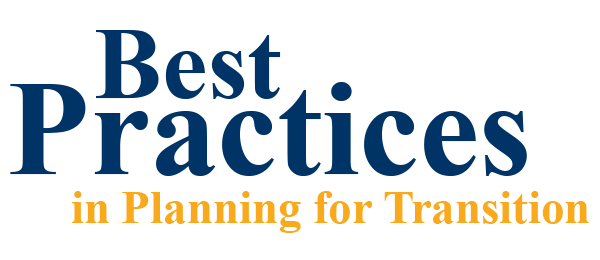Reference this module as:
Morningstar, M.E., Lattin, D.L., Erickson, A.G. (2008). Best practices in planning for transition. [Online Training Module]. Lawrence, KS: University of Kansas, Department of Special Education. Retrieved from: www.transitioncoalition.org
Credits:
- Graphic Design: Ginny Weaver Design
- Programming: Ginny Weaver Design and ERI, Inc.
- All contents Copyright 2008 by the Transition Coalition
References:
- Cronin, M. E. (1996). Life skill curricular for students with learning disabilities: A review of the literature.Journal of Learning Disabilities, 29(1).
- Halverson, D., Kirschman, C., Petersen, B., Rounds, D. ( 2006 ) Technical Assistance Guide for Transition in the IEP. Retrieved April 22, 2008 from the South Dakota Transition Services Liaison Project website:www.tslp.org
- Johnson, D.R., Stodden, R.A., Emanuel, E.J., Lueking, R., & Mack, M. (2002). Current challenges facing secondary education and transition services:What research tells us. Exceptional Children, 68(4). 591-531.
- Morningstar, M.E., Lattin, D.L., & Sarkesian, S. (2004). People Make It Happen. Lawrence, KS: The University of Kansas, Department of Special Education.
https://transitioncoalition.org/wp-content/uploads/2015/01/peopleMakeItHappen_8-20091250526573.pdf
- National Council on Disability. (1989). The education of students with disabilities: Where do we stand?Washington, DC: Author. http://www.ncd.gov/newsroom/publications/1989/stand.htm
- National Council on Disability. (1996). Achieving independence: The challenge for the 21st Century-A decade of progress in disability policy-Setting an agenda for the future. Washington, DC: Author.http://www.ncd.gov/newsroom/publications/1996/achieving.htm
- National Council on Disability. (2000). Transition and post-school outcomes for youth with disabilities: Closing the gaps to post-secondary education and employment. Washington, DC: Author.http://www.ncd.gov/newsroom/publications/2000/transition_11-01-00.htm
- National Secondary Transition Technical Assistance Center (2008) What is Indicator 13? Retrieved November 1, 2007 from the NSTTAC website: www.nsttac.org
- O’Leary, E. (2005, January).Overview, comments and recommended action for transition services: Individuals with Disabilities Education Improvement Act of 2004. Unpublished white paper. (Available from Ed O’Leary,[email protected])
- O’Leary, E. & Collison, W. (2002, February). Transition services: Helping educators, parents and other stakeholders understand: Postschool outcomes, course of study, coordinated set of activities.
- Sax, C. & Thoma, C. (2002). Transition assessment: Wise practice for quality lives. Baltimore, MD: Paul H. Brookes Publishing Company.
- Sitlington, P. (1996). Transition to living: The neglected components of transition programming for individuals with learning disabilities. Journal of Learning Disabilities, 29(1), 31-39, 52
- Storms, J., O’Leary, E., & Wiliams, J. (2000, May). Transition requirements: A guide for states, districts, schools, universities, and families. Eugene, OR: Western Regional Resource Center.http://interact.uoregon.edu/wrrc/wrrc.html
- Wandry, D., & Repetto, J. (1993). Transition services in the IEP. NICHCY Transition Summary, 3(1).
- Wright, P. & Wright, P. (2006). Chapter 12 – SMART IEPs. Wrightslaw: From Emotions to Advocacy (2nd edition). Downloaded from http://www.wrightslaw.com/bks/feta2/feta2.htm on May 6, 2008.

